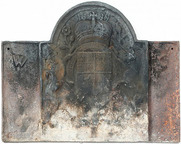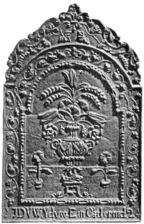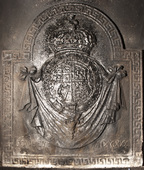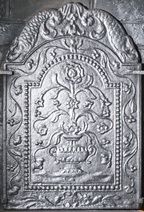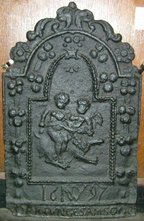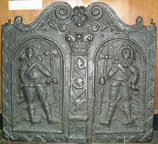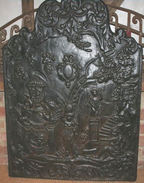-
1281
Description: Composite; arched rectangular shaped, armorial fireback, cavetto edging, with Stuart Royal arms, garter, supporters, crown and motto, and 1639 date above crown; this overlies a rectangular plate with fillet edging; top centre in the space each side of the central shield, an initial letter - W to left, C to right.
Notes: One of several variants using a fireback with the English Stuart royal arms, the date probably altered according to when it was cast. The original date of the fireback was probably 1619. Garth's Auctioneers, Columbus, OH, 3 Jan 2015, lot 2347 ($300).
Inscription: 1639 / W C
Arms: English Stuart royal
- Decoration tags:
- rectangular with round arch (shape)
- fillet (edging)
- carved stamps
- whole carved pattern
- composite
- extension panels
- heraldic
- armorial
- royal
- text
Manufactured: in 1639 possibly in the Forest of Dean area of England.
Current location: not known.
-
71
Description: Fragment; upper half of an arched rectangular shaped fireback; fillet edging; divided into two halves; left half - naked female figure of Truth holding scales in right hand, surrounded by motto ribbon bearing the text: HET IS V EEN SCHADE DAT TROVE IS LICHTER DAN EEN PLV; right half - naked female figure of Vigilance, a bird seated on her right hand, and with two dogs on leads held in her left hand, surrounded by a motto ribbon bearing the text: ICH IAGE OM DIE VINDEN OFT ICH TROVE KONDE VINDEN; initials between scales; date divided by cross of an orb forming the centre of the four intended panels.
Notes: The complete fireback has four figures (clockwise from top left) representing Truth, Vigilance (both naked), Indifference and Perfidy (both clothed).
Copies of this fireback are known.
Inscription: SG 1598 HET IS V EEN SCHADE DAT TROVE IS LICHTER DAN EEN PLV / ICH IAGE OM DIE VINDEN OFT ICH TROVE KONDE VINDEN
- Decoration tags:
- rectangular with round arch (shape)
- fillet (edging)
- whole carved pattern
- individual numbers
- allegorical
- text
- animals
- humans
- objects
Manufactured: in 1598 possibly in the Lorraine area of Germany.
Current location: Godalming Museum, Godalming, Surrey, England.
Museum number: B980.407 (part of the Godalming Museum museum group)
- Attached to series:
- Virtues and Faults firebacks
-
858
Description: Arched rectangular shaped central panel, bead-and-pellet on fillet edging, narrow-necked, two-handled urn with flowers and wheat ears issuing therefrom, the vase resting on paving, upon which are two small flowers in pots with a stool between; arched rectangular shaped border with fillet edging and symmetrical floral tendrils, a looped 'W' in each shoulder; on top, mirrored leaves, tendrils and wheat ears; inscription along bottom of border.
Notes: One of the two largest of six flower vase designs in this series (see also no. 885). All incorporate the looped 'W' motif which may be intended to identify the pattern maker. The inscription translates as 'God is our strength'. Illustration from Goodwin-Smith, 1936 (from the Bratt Colbran collection).
Copies of this fireback are known.
Inscription: 17 DVW Ydyw Ein Cadernid 24
Manufactured: in 1724 in England.
Current location: not known.
Citation: Goodwin-Smith, R., 1936, 'Some English Firebacks', The Connoisseur, 97, pp. 36-8.
- Attached to series:
- 1724 series
- Welsh inscription series
- British 'Dutch' style firebacks
-
1292
Description: Arched rectangular shape; Greek Key border with fillet edges; in high relief, in front of swagged drapery, the shield of, quarterly, France quartering England, Scotland and Ireland, surrounded by a Garter, and surmounted by a ducal coronet; below, the inscription in capitals.
Notes: The use of the Greek Key design as a border is believed to be unique for an English fireback. Although somewhat indistinct, the use of the Stuart royal arms and the ducal coronet can be explained by the fact that the fireback was one of a group cast for the 2nd Duke of Richmond, whose father, the 1st duke, was the illegitimate son of Charles II and Louise de Kéroualle. The Richmond arms were differenced from the Stuart royal arms by the addition of a bordure compony (the detail of which is not distinct on this casting). Sowley Furnace, near Beaulieu in Hampshire, was owned in 1732 by John, 2nd Duke of Montagu, and was let to Miles Troughton. An identical fireback also at Goodwood is dated 1731 and a similar, but smaller, variant of this fireback, is dated 1732.
Copies of this fireback are known.
Inscription: HONI SOIT QUI MAL Y PENSE / SOWLEY MDCCXXX
Arms: Duke of Richmond
- Decoration tags:
- rectangular with round arch (shape)
- fillet (edging)
- whole carved pattern
- heraldic
- armorial
- royal
- text
Manufactured: in 1730 at Sowley Furnace, Beaulieu in the New Forest area of England.
Current location: Goodwood House, Westhampnett, West Sussex, England.
-
1230
Description: Arched rectangular central panel with bead-on-fillet edging; gadrooned vase with a quasi-symmetrical arrangement of fronds, leaves and flowers issuing therefrom, topped by a central bloom; arched rectangular border with fillet edging and a quasi-symmetrical arrangement of fronds, leaves and flowers descending from top centre; at the bottom, leaves splayed from a central cartouche enclosing an indecipherable initial or monogram; on top, symmetrical sea serpents descending from a central beribboned pendant.
Notes: A familiar type of design seen on many small firebacks/gratebacks of this period.
Inscription: [indecipherable]
Manufactured: in the early-18th century in England.
Current location: Godinton House, Great Chart, Kent, England.
- Attached to series:
- British 'Dutch' style firebacks
-
83
Description: Arched rectangular shaped central panel, bead-and-pellet edging, semi-naked male figure, wearing a floral head-dress and carrying a basket of produce, initials in top corners; arched rectangular shaped border, fillet edging, symmetrical festoons of foliage, floral scrolls at base, date in an oval cartouche; on top, two putti, two dolphins and scrolled foliage, all symmetrical.
Notes: An allegory of Spring, based closely on an engraving, dated 1600, by Hendrik Goltzius (1558-1617); one of a series of large firebacks of similar date, all bearing the initials, GK.
Copies of this fireback are known.
Inscription: G K / 1700
- Decoration tags:
- 'Dutch' (shape)
- fillet (edging)
- whole carved pattern
- individual letters
- date stamp
- pictorial
- allegorical
- text
- humans
Manufactured: in 1700 possibly in the Siegerland area of Germany.
Current location: Guildford Museum, Guildford, Surrey, England.
Museum number: S,7111 (part of the Guildford Museum museum group)
Citation: Pesch, D., 1982, Herdgussplatten (Rheinland-Verlag, Koln).
- Attached to series:
- 'Dutch' GK series
-
77
Description: 'Dutch' style; arched rectangular shaped central panel, bead edging, two children sitting astride a beast (possibly a winged ram); arched rectangular shaped border, fillet edging, swags of fruit bunches suspended from ribbon; on top, symmetrical floral swirls and flowers.
Notes: The image is probably intended to be Phrixus and Helle riding the winged ram with the golden fleece, but in recasting it has been misinterpreted as the young Samson slaying the lion at Timnath; Judges 14: 5-6.
Copies of this fireback are known.
Inscription: 16 NDW 97 / DER JUNGE SAMSON [the young Samson]
- Decoration tags:
- 'Dutch' (shape)
- fillet (edging)
- whole carved pattern
- individual letters
- individual numbers
- biblical
- monogram
- text
- humans
Manufactured: in the late-17th to early-18th century possibly in the Weald area of England.
Current location: Guildford Museum, Guildford, Surrey, England.
Museum number: G.486 (part of the Guildford Museum museum group)
- Attached to series:
- 'Dutch' NDW series
-
81
Description: Rectangular with two mirrored scrolls on top, a lion’s face between; bas-relief semi-circle edging (sides and bottom); central pilaster with vine scrolling, Corinthian capital, initials on the pedestal; on either side, an arched alcove, each with a halberdier in mid-17th century clothes, their feet pointing to the middle.
Notes: Stylistically similar to the Lenard fireback (no. 429), the initials also appear on other firebacks. All known examples of this fireback are poorly modelled and cast. A rare version (no. 400) has different edging and lacks the pattern-maker’s initials.
Copies of this fireback are known.
Inscription: IM
- Decoration tags:
- rectangular with ornate arch (shape)
- fillet (edging)
- whole carved pattern
- planklines
- pictorial
- architectural
- text
- humans
Manufactured: in the early- to mid-17th century possibly at Brede Furnace in the Weald area of England.
Current location: Guildford Museum, Guildford, Surrey, England.
Museum number: S.7108 (part of the Guildford Museum museum group)
Citation: Lloyd, N., 1925, 'Domestic Ironwork I', Architectural Review, 58, pp. 58-67.
- Attached to series:
- IM series
- Brede group
-
82
Description: 'Dutch' style; arched rectangular shaped central panel, bead on fillet edging, naturalistic scene of a heron with wings extended catching a fish, water below, clouds above, plants in background; arched rectangular shaped border, fillet edging, symmetrical scrolled tendril pattern; at bottom, two looped 'W' figures between date split corners; on top, symmetrical scrolled foliage. A single central vertical plankline.
Notes: The image of the heron is taken from a print, by Wenceslaus Hollar c.1658, of an etching by Francis Barlow (c.1626-1704); the style of the date suggests a similar pattern maker to a series of firebacks, of the same date, some bearing a Welsh inscription. All incorporate the looped 'W' motif which may be intended to identify the pattern maker. The small size of this fireback makes it likely that it was intended to be fixed to the back of a grate.
Copies of this fireback are known.
Inscription: 17 24
- Decoration tags:
- 'Dutch' (shape)
- fillet (edging)
- whole carved pattern
- planklines
- pictorial
- text
- animals
Manufactured: in 1724 in England.
Current location: Guildford Museum, Guildford, Surrey, England.
Museum number: G.487 (part of the Guildford Museum museum group)
- Attached to series:
- 1724 series
- British 'Dutch' style firebacks
-
86
Description: Quasi-arched rectangular shape; fillet edging; central female figure with urn on head, above which is an oval cartouche (possibly a mirror); to left, fireplace with basket grate, above which a lobster and another (unidentified) creature bear a covered vase; to right a seated female figure stretches forth her left arm, behind her is a statue of a female figure on a plinth at the foot of a curving flight of stairs; the whole is surrounded by naturalistic rocks and trees, suggesting a grotto.
Notes: An unusually free pictorial decoration.
Copies of this fireback are known.
- Decoration tags:
- rectangular with ornate arch (shape)
- fillet (edging)
- whole carved pattern
- pictorial
- humans
- plants
- objects
Manufactured: in the early-18th century in England.
Current location: in private hands, Hadlow Down, East Sussex, England.
- Attached to series:
- Late pictorial series (all)
- Late pictorial series 4
